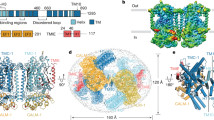Abstract
Mammals perceive sounds thanks to mechanosensory hair cells located in the inner ear. The stereocilia of these cells are tightly bound together in bundles by a network of cadherins and scaffolding proteins. Stereocilia deflection induces stretching of this network and is responsible for hair cell depolarization that triggers the neuronal message, transducing the mechanical signal into an electric signal transmissible to the brain. Nearly all proteins involved in this mechano-electrical transduction network contain short C-terminal motifs of interaction with PDZ domains (PSD-95, Discs Large, ZO-1). Interestingly only two of these proteins encompass PDZ domains: Harmonin and Whirlin. As our first step towards a comprehensive structural study of Whirlin, we have assigned the 1H, 13C and 15N backbone resonances of a tandem formed by the first two PDZ domains of Whirlin, reported the secondary structure elements of this tandem as predicted by the TALOS+ server and evaluated its dynamics from 15N relaxation measurements.


Similar content being viewed by others
References
Assad JA, Corey DP (1992) An active motor model for adaptation by vertebrate hair cells. J Neurosci 12:3291–3309
Barbato G, Mitsuhiko I, Kay LE et al (1992) Backbone dynamics of calmodulin studied by 15 N relaxation using inverse detected two-dimensional NMR spectroscopy: the central helix is flexible? Biochemistry 31:5269–5278
Boëda B, El-Amraoui A, Bahloul A et al (2002) Myosin VIIa, harmonin and cadherin 23, three Usher I gene products that cooperate to shape the sensory hair cell bundle. EMBO J 21:6689–6699
Chang BH, Gujral TS, Karp ES et al (2011) A systematic family-wide investigation reveals that ~ 30% of mammalian PDZ domains engage in PDZ–PDZ interactions. Chem Biol 18:1143–1152
Chi CN, Haq SR, Rinaldo S et al (2012) Interactions outside the boundaries of the canonical binding groove of a PDZ domain influence ligand binding. Biochemistry 51:8971–8979
Delaglio F, Grzesiek S, Vuister GW et al (1995) Nmrpipe—a multidimensional spectral processing system based on UNIX pipes. J Biomol NMR 6:277–293
Gillespie PG, Müller U (2009) Mechanotransduction by hair cells: models, molecules, and mechanisms. Cell 139:33–44
Long J, Wei Z, Feng W et al (2008) Supramodular nature of GRIP1 revealed by the structure of Its PDZ12 tandem in complex with the carboxyl tail of Fras1. J Mol Biol 375:1457–1468
Maisonneuve P, Caillet-Saguy C, Raynal B et al (2014) Regulation of the catalytic activity of the human phosphatase PTPN4 by Its PDZ domain. FEBS J 281:4852–4865
Mburu P, Mustapha M, Varela A et al (2003) Defects in whirlin, a PDZ domain molecule involved in stereocilia elongation, cause deafness in the whirler mouse and families with DFNB31. Nat Genet 34:421–428
Petit CM, Zhang J, Sapienza PJ et al (2009) Hidden dynamic allostery in a PDZ domain. Proc Natl Acad Sci 106(43):18249–18254
Ren J, Feng L, Bai Y et al (2015) Interdomain interface-mediated target recognition by the Scribble PDZ34 supramodule. Biochem J 468:133–144
Shen Y, Delaglio F, Cornilescu G, Bax A (2009) TALOS+: a hybrid method for predicting protein backbone torsion angles from NMR chemical shifts. J Biomol NMR 44:213–223
Vranken WF, Boucher W, Stevens TJ et al (2005) The CCPN data model for NMR spectroscopy: development of a software pipeline. Proteins 59:687–696
Yan J, Pan L, Chen X et al (2010) The structure of the harmonin/sans complex reveals an unexpected interaction mode of the two Usher syndrome proteins. Proc Natl Acad Sci 107:4040–4045
Ye F, Zhang M (2013) Structures and target recognition modes of PDZ domains: recurring themes and emerging pictures. Biochem J 455:1–14
Zhu G, Xia Y, Nicholson LK, Sze KH (2000) Protein dynamics measurements by TROSY-based NMR experiments. J Magn Reson 143(2):423–426
Acknowledgments
We thank F.X. Cantrelle (UCCS-UGSF, Lille) and C. Simenel (NMR unit, Institut Pasteur) for their NMR technical expertise and helpful discussions. This work was supported by the Programme Transversal de Recherche from the Institut Pasteur (PTR Grant No. 483) and the Ministère de l’Enseignement Supérieur et de la Recherche (Grant No. 883/2013 to F.D.). Financial support from the TGIR-RMN-THC Fr3050 CNRS for conducting the research is gratefully acknowledged.
Author information
Authors and Affiliations
Corresponding author
Rights and permissions
About this article
Cite this article
Delhommel, F., Wolff, N. & Cordier, F. 1H, 13C and 15N backbone resonance assignments and dynamic properties of the PDZ tandem of Whirlin. Biomol NMR Assign 10, 361–365 (2016). https://doi.org/10.1007/s12104-016-9701-z
Received:
Accepted:
Published:
Issue Date:
DOI: https://doi.org/10.1007/s12104-016-9701-z




